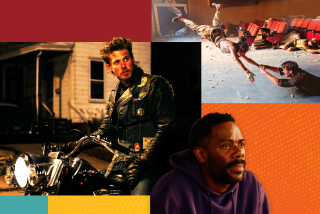Why shoot ‘Bridge of Spies’ and ‘Hateful Eight’ on film instead of digital? For the ‘emotion in the emulsion’
Is digital Hollywood’s destiny? It’s certainly cheaper than film stock — directors can shoot as much as they like without eating up their production budget. And its pixels pack a punch in terms of sharpness and clarity. Digital cinema’s lure has become so strong that Kodak nearly quit making photochemical film stock altogether last summer. But the shutdown didn’t happen, thanks to a campaign spearheaded by director Christopher Nolan and supported by a significant minority of filmmakers who remain devoted to the celluloid cause.
And their ranks may be growing. Last year, best picture Oscar nominees “Boyhood,” “Foxcatcher,” “The Grand Budapest Hotel” and “The Imitation Game” were all filmed on 35-millimeter stock. This fall, the number of awards contenders put forth by storytellers who still believe in capturing images the old-fashioned way has grown to at least seven, including “Bridge of Spies,” “The Hateful Eight,” “Star Wars: The Force Awakens,” “Son of Saul,” “The Big Short,” “Spectre” and “Joy.”
SIGN UP for the free Indie Focus movies newsletter >>
“It’s almost a novelty to shoot on film now,” says “Bridge of Spies” cinematographer Janusz Kaminski, who won Oscars for “Schindler’s List” and “Saving Private Ryan.” “But there’s more emotion in the emulsion, when you compare it to digital imagery. There are advantages to digital technology, but what’s disappearing is the shadows. I like shadows, I like high contrast, I like smoke.”
Teamed once again with director Steven Spielberg on “Bridge of Spies,” Kaminski savored the medium’s ability to evoke a sense of mystery. “Too often I think with digital it gets down to: ‘Well, the image is in focus, it’s sharp — I got it.’ For me, that’s the wrong approach. Shooting on film, my job is to support the story with visual metaphors that have more to do with psychology. I take an emotional approach to the image that can’t be represented on the video monitor.”
Kaminski applied his astute eye for color, light and shadow to the “Bridge of Spies” saga, beginning with the warm tones that depict 1957 America, progressing to a gray palette for Cold War-era East Berlin and culminating in the dramatic exchange of prisoners, when Tom Hanks’ hero attorney, James Donovan, watches Soviet spy Rudolf Abel (Mark Rylance) walk past Checkpoint Charlie toward Soviet handlers, the tension building “because we still don’t know what’s going to happen to Mark’s character. I photographed it darker and a little more violent in terms of light being pointed right toward the camera and flaring the lenses. The bridge is this bigger-than-life metaphor for the whole movie and the photography needed to reflect that.”
Kaminski says he might go digital at some point in the future, praising peers Roger Deakins and Emmanuel Lubezki for their artful transitions from film to video. By contrast, László Nemes, writer-director of Hungarian Oscar submission “Son of Saul,” refuses to even contemplate a filmmaking future absent 35-millimeter stock.
“When there’s no more film, then I will stop making movies and do something else,” he says. “You can never compare pixels to photochemical grain that lives from one image to the next and cannot be controlled. I don’t think human experience should be recorded only in zeros and ones. I think that kills the life within the image.”
Winner of the Cannes Grand Prix, “Son of Saul,” shot by Mátyás Erdély, follows a Jewish Sonderkommando forced to help Nazis at Auschwitz-Birkenau. Filming the stark story on 35-millimeter stock galvanized cast and crew, Nemes says. “Shooting in this traditional way pushed everybody to concentrate and deliver their best performance. We had a limited amount of time to shoot the film and a limited amount of raw film stock, so we had to establish exactly what we wanted beforehand. We chose our angles very carefully to capture this very specific, very tight, very coherent subject matter.”
The most conspicuous use of photochemical film this season comes courtesy of Quentin Tarantino’s widescreen epic “The Hateful Eight.” Shot on 65-millimeter film stock by director of photography Robert Richardson, who won Academy Awards for “Hugo,” “The Aviator” and “JFK,” the movie will be released on the near-obsolete 70-millimeter projection format in about 100 theaters on Dec. 25.
“Hateful Eight” executive producer Shannon McIntosh believes the new movie expands on Tarantino’s fascination with physical film. “Quentin loves seeing 24 frames per second flickering through the film projector,” she says, pointing to his stewardship of Los Angeles’ New Beverly Cinema, which he purchased in 2007 and vowed to maintain as a “bastion for 35-millimeter films,” along with his screening of “Pulp Fiction” at the 2014 Cannes film festival. “It was the only 35-millimeter movie at Cannes that year,” McIntosh recalls. “We showed ‘Pulp Fiction’ on the beach and it played wonderfully. Around that same time, Quentin started talking about making his next movie in 65/70.”
Tarantino’s films famously teem with references to motion pictures that have come before. That reverence for cinematic tradition seems to have fueled his passion for celluloid in general and “Hateful Eight’s” old-school widescreen format in particular. During pre-production, McIntosh recalls, “Quentin went to Panavision and watched the ‘Ben Hur’ chariot sequence projected in 70-millimeter and he loved it. Quentin was like, ‘OK, we have to figure out how to make this work.’”
More to Read
The biggest entertainment stories
Get our big stories about Hollywood, film, television, music, arts, culture and more right in your inbox as soon as they publish.
You may occasionally receive promotional content from the Los Angeles Times.










